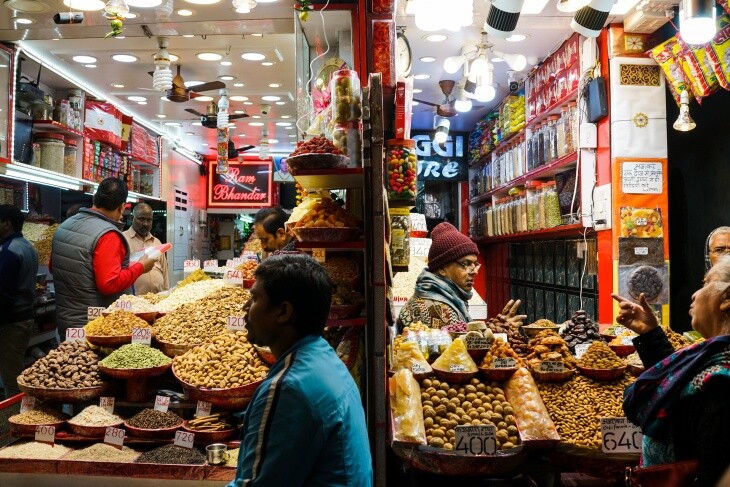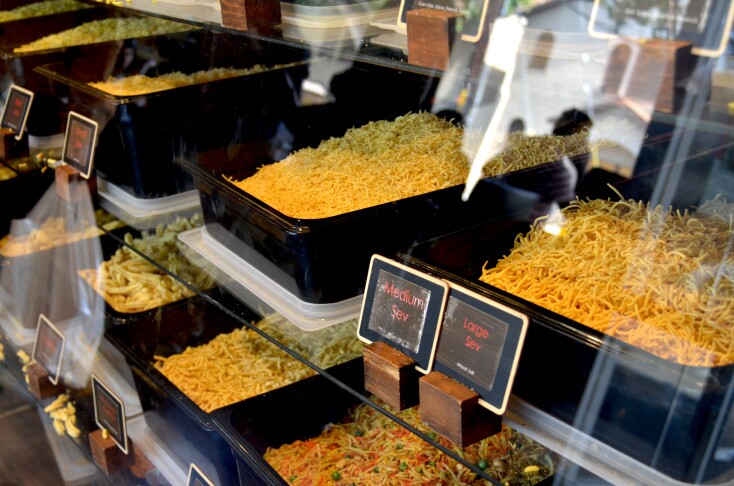Truth matters. Community matters. Your support makes both possible. LAist is one of the few places where news remains independent and free from political and corporate influence. Stand up for truth and for LAist. Make your year-end tax-deductible gift now.
How To Shop An Indian Market Like A Pro
Want to know how many Los Angeles residents have never been to Little India? Too many. The approximately five block stretch of Pioneer Boulevard in Artesia hasn't received an official designation because politicians decided that calling it Little India would recognize one cultural group over another... which is the exact point of Koreatown, Thai Town, Little Tokyo and Little Armenia. But whatever.
Most people, if they know about Indian markets at all, primarily know of India Sweets and Spices, the Atwater Village-based store with eight other locations from Riverside to Canoga Park. The store is fine, don't get me wrong. I like their vegan jackfruit curry, the dhal at their hot bar is almost as good as my mom's and sometimes they have free self-help booklets (but skip the one titled "How to Change People," which just talks about making peace with pain). After I picked up a bag of cardamom as small as my cat's paw and saw it was priced at $10.99, my cynicism about India Sweets & Spices was cemented. It's more expensive than it should be and it doesn't carry a wide range of products, so I only go there if I'm pressed for time or need to grab a couple of quick items.

Instead, I head to Artesia. Put on your favorite podcast and set your GPS to Surati Farsan Mart. You'll arrive in the middle of Little India, five-ish walkable blocks where you'll find everything you need to plan an elaborate Indian wedding or stage an appropriated bhangra hip-hop class. You can drop mad $$$ on saris, gold bangles, incense (Nagchampa is still the best) and, of course, food.
Pioneer Cash & Carry is among the biggest grocery stores here. If you only need a few items, Surati Cash & Carry, at the same corner, is smaller, homier and less crowded. Both accept credit cards. Plus, there's free street parking for an hour. As you're strolling the boulevard, when you hit the Jack in the Box and start seeing Korean signage, you've gone too far.
These foods are either staples in my house, as they were in my parents' home, or stake claim in Indian culture, although they haven't been widely fetishized by Americans — yet.

Freshly fried chakli at Surati Farsan Mart
Colonialism sucks but tea is very nice and Indian people love the stuff. Along with afternoon tea, often served with milk and copious amounts of refined sugar, there are the requisite snacks and chakli may be the most universal. Deep fried until it's crisp but not brittle, this savory spiral is irresistible when it's greasy and hot. It's still good at room temperature from a tupperware box, if you can save it that long. Made from rice flour, urad dal flour and chickpea flour, chakli gets its signature taste from jeera (cumin seeds). You'll see packaged versions of it everywhere. Fresh chakli is harder to find. At Surati Farsan Mart, look for it immediately to the left of the main sweets case, which is a bit hidden from view when you walk in the front door. Because this place is always busy (I've never come here and not encountered a line), the high turnover among items means you have good odds of getting a fresh batch. Chakli shouldn't be so hard that you need a gold-tier dental plan to eat it, and many packaged versions have this problem. The best chakli is crisp yet buttery, almost crumbling in your mouth. It's sometimes anglicized as chakali or chakri.

Masala Lemonade at Surati Farsan Mart
Also known as masala nimbu pani, which means spiced lemon water in Hindi, this drink is exactly what it sounds like. Freshly squeezed lemon juice with a bit of salt, cumin and sugar. You'll see it sometimes in India, although its unspiced permutation, nimbu pani, is far more popular. In the Mumbai heat, street vendors will use manual juicers that look like medieval torture devices to crank out glasses of the libation to grateful passers by. Usually there's no ice. Too expensive, too inconvenient to carry. The salt, however, combined with the citrus, makes it deeply refreshing. If you want the masala version, look for the telltale sediment of brown spices at the bottom of the cup.

Pickle
For me, the idea of eating dhal and rice without pickle is inconceivable. It's a standard facet of the Indian thali, compulsory with vegetarian food, especially in South India, and is always in the fridge. It does do the job of adding spice and flavor but it's more than a hot sauce. Aged (although not fermented) like kimchi, it's basically a vegetable, occasionally a fruit (mango, chili, lime and carrot are especially popular), mixed with oil, lots and lots of salt and chili powder. Its age, a few days at minimum, gives it a depth of flavor that can't be otherwise achieved. Although my mom makes her own these days, when I was growing up she always bought Priya and Nirav brands, which I stick to.

Parle-G Biscuits
These are real O.G. and mostly eaten by people under the age of five because nostalgia is the most potent flavor. Every corner store in India sells these biscuits and they're a fixture of Indian youth. (They're also, according to Nielsen, the best-selling brand of biscuits in the world.) The branding hasn't changed since the 1950s, and I'm willing to bet the recipe hasn't either. There's nothing remarkable about these cookies. I've only ever seen them in one flavor. They're so simple, so plain and comforting that they can't be improved upon. You can dunk them in milk or serve them with afternoon tea. These hold a lot of real estate in Indian childhoods, including mine.

Frozen Parathas
For whatever reason, parathas haven't caught on stateside like naan or dosa, which is a shame because they're as layered as a Faulkner novel, as structurally complex as a croissant and every bit as buttery. You'll see street vendors all across India preparing these, stretching dough as if they're making taffy. They pull it several feet tall, fold it upon itself, stretch and fold it again until the resulting strata is layered like a Jurassic monolith. The result is one of the most delicate, flaky, chewy class of carbs ever invented. You can eat parathas in place of naan or with a fried egg, as you'll often see at street stalls. I don't have a specific brand to recommend but you should know that parathas and aloo parathas are entirely different items, made from different types of dough. Perusing the packages, look for pictures of parathas that look flaky and contain the telltale spiral. When you buy them, pan frying instead of microwaving makes all the difference.

Paan at K.C. Paan & Chaat House
Paan defies categorization. It's not quite a dessert, not quite medicinal. It's more of a digestif. Except it's food not drink. It's eaten after meals but between them too. It's decidedly more sweet than savory. Betel leaf, largely unused in Western cooking, functions as an envelope for crushed rose petals, candy-coated fennel (the pink and white kind you see at the counter of Indian restaurants), mint-flavored fennel, coconut and katha paste. The last of these is derived from acacia trees. When mixed with lime, katha gives paan its characteristic crimson color, which lingers on your teeth. Walk the streets of any Indian city and you'll see paan stalls on every corner. Beside them, old men dressed in lungis (best described as wrap-around skirts) will be shooting the breeze, their mouths stained blood red. You'll also notice crimson splashes on the sidewalk, spit stains so vibrant and difficult to remove that Thailand passed laws discouraging betel's consumption.
The snack has an old school reputation — some varieties come with smokeless tobacco that's decidedly retro — but younger generations buy it too. At K.C. Paan & Chaat House, you can see the fresh betel leaves sitting on the counter, along with an array of condiments like chocolate, saffron, and mango. All in all, there are 30+ different types of paan on the menu, each with its unique permutation of condiments encased in the standard betel leaf. Menu option #4 is more or less the standard. Dense yet refreshing, the anise flavor is so marked you can't eat more than one but one is just enough.

Sev
Sev is the catch all name for a variety of chickpea flour-based snacks, extruded until they're as thin as vermicelli, then deep fried. They're the basis for a lot of Bombay street food. Almost all chaat — the name for this type of street food, seen all over India — features sev, as well as boiled potatoes puris, yogurt and the tamarind and mint chutneys that have come to be expected at Indian American restaurants.
At home, I'll sprinkle sev on dhal and rice to give it an added crunch or mix it with chopped onions and tomatoes to resemble bhel puri: chaat made with savory spiced puffed rice. I'll sometimes sprinkle it over cucumbers drizzled with almond yogurt, a lazy bastardization of raita and chaat. The possibilities are endless. There's something about sev, although it's deep-fried, that is utterly light. It's not nearly as greasy as most potato chips and the level of spice is so subtle that you could eat a whole bag. It, too, is a staple in my family's pantry. Haldiram's is a legit brand, one I'd recommend unless you're lucky enough to find it freshly made in-house, which you can do at Surati Farsan Mart.

BONUS: Paneer Tikka Pizza at Chicago's Pizza With-A-Twist
More than 10 years ago, I ate what remains one of the best pizzas of my life, a palak paneer pizza at Pizza Hut (yes, Pizza Hut) in Bangalore, India. Imagine a crisp, deep dish pie with a crackling crust slathered in a thick spinach gravy punctuated with garam masala, ginger and garlic. All of this was blanketed by mozzarella, studded with chunks of golden brown paneer and flecked with jam-like caramelized peppers, tomatoes and onions. I think about that pizza about all the time. I finally found the closest thing at Chicago's Pizza With-A-Twist. I know this isn't a market item but it was too good not to include.
It's the first Southern California outpost of a NorCal-based chain with franchises in Bakersfield and Fresno. The entire menu is an Indian-inflected take on your classic pizza joint featuring aloo chaat, palak paneer and tandoori chicken pies. Tandoori buffalo wings and shahi paneer pastas round out the options. While my paneer tikka pizza wasn't nearly as tikka as I would've liked — the fresh coriander and vaguely spicy cream sauce were the only things that set it apart — it was good enough that when I dropped its cheesy goo on my lap, I scooped the remnants into my mouth. Manager Taranjit Rana tells me the paneer tikka is the most popular pizza, and I understand why. Also, bonus points for carrying gluten-free crusts (which are excellent), Daiya vegan cheese and Jain-friendly options: no mushrooms, onion, garlic or egg.







